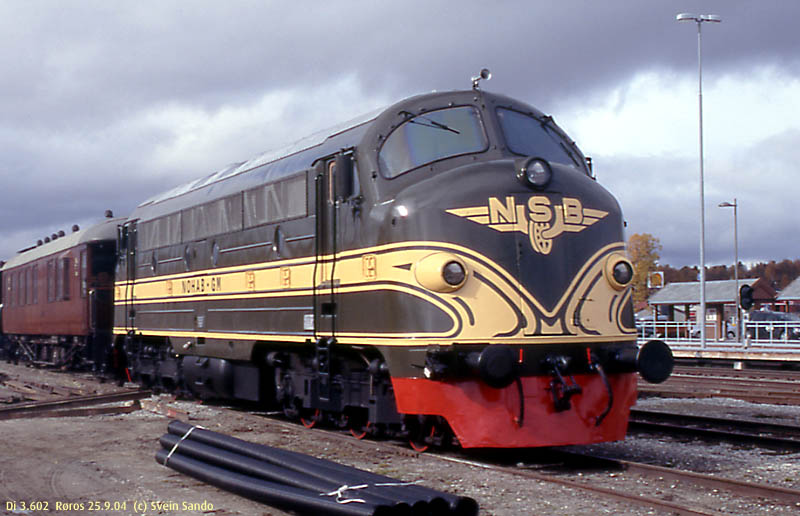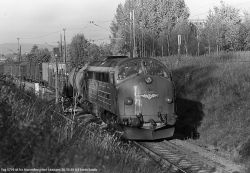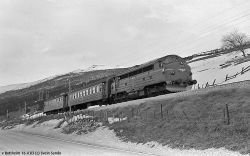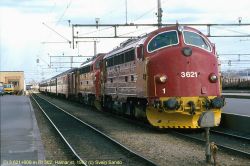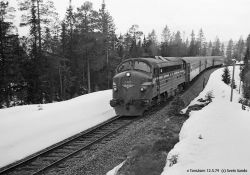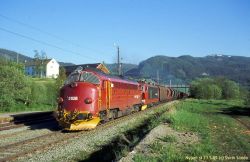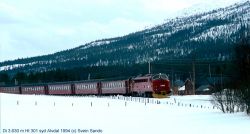|
Di 3 - The most important locomotive on the non-electrified railways of Norwegian State Railways (NSB)
Brief historyThe famous Di 3-engines is history, at least as at NSB. The year 2000 was the last year in ordinary service. The engine became the main diesel engine class, and these engines were to replace steam engines as a result of the "Get-rid-of-the-steam"-program decided in the Norwegian parliament (Stortinget) in 1955. The Norwegian steam engines were old and worn out after the World War II. They were expensive to use and used the fuel very badly (5-10 % efficiency). Since the 1920-ies electric traction had been the alternative to steam, but to electrify the railways was very expensive and was only profitable on railways with fairly large traffic. In 1952, the parliament decided to electrify 50 % of the railway network, which ment 80 % of the traffic. The remaining 20 % of the trains, and for the railways waiting to be electrified during the electrifcation time, NSB needed an alternative to steam. From 1954 NSB tested a General Motors diesel electric locomotive, built on licence by NoHAB, Trollhättan in Sweden. The test engine was designated by NSB as class 64, no. 2246. The engine was tested especially on the Nordland railway and was soon accepted and considered to be reliable. Five new engines (nos. 603-607) were ordered and put into service in 1957. The test engine no. 2246 was bought and given the number "602". The same year (1957) NSB ordered eight new engines (nos. 608-615). At this time the engines were used at the Dovre line, the Nordland line and on the Gjøvik/Bergen line. Shortly afterwards, another six engines were ordered to be delivered in 1958. At that time some weak bridges on the Hamar-Otta line were replaced or strengthened such that the engines could be used on the while line between Trondheim and Hamar via Dombås. On the Rauma line (Dombås-Åndalsnes) Di 3 was put into service in the sleepers from 1958. The steam engines were used parallel with Di 3 until 1965. The Finish State Railways (VR) originally ordered the engines nos. 622-623 and nos. 641-643, but they cancelled the order. The engines were offered to NSB who accepted. Three of these engines (nos. 641-643), were already made with four driving axles in stead of six. They were named class Di 3b (confer technical data below). The two other engines were at an earlier stage in construction and could more easily be made similar to the original Di 3-engines. Even so, these two engines (nos. 622-623) were a third variant of Di 3, but never the less called Di 3a like the previous engines. The engines were put into service in 1960. In the end of 1960, 17 of the engines were used by Trondheim district, two had home base in Hamar running in conjunction with Trondheim engines and six engines were on the Bergen line. At the Røros line the Di 3 engines were hardly used due to some few weak bridges. In 1960, however, a new concrete bridge at Reitan was constructed and the most important obstacle for usage of heavier engines was abandoned. In February 1961 the Oslo-Gjøvik/Hønefoss lines was electrified. Thus diesel or electric engines could haul all fast trains on the Bergen line. Simultaneously the Nordland line was extended which meant increased need for engines. In February 1962 the line was finished to Bodø. Later the same year the Bergen line was electrified westwards to Ål with consequently less need for non-electric locomotives. The Røros line was often visited by Di 3 engines and from May 1964 it was used on regular basis. That year the Bergen line was completely electrified and 5-6 Di 3 engines were available for other lines. One Di 3 was however kept as pusher for the rotating snow plough at Finse and as a reserve. In 1965 the engines nos. 624-629 were delivered and that ended steam hauled fast trains on the Røros line. In the late 1960-ies NSB electrified the Gudbrandsdal line (Hamar-Otta-Dombås) and the Dovre line (Dombås-Støren-Trondheim). In 1967 the electric trains reached Otta, and Dombås one year later. Di 3 engines could then be used on less important non-electrified lines, such as Valdres line which at the same time was strengthened for these heavier engines. Finally, in 1969, the last Di 3 engines were delivered from NoHAB (nos. 630-633) and the rest of the bigger steam engines could be redrawn. I the autumn 1970 the electrification of the Dovre line was completed. The last steam engine was taken out of regular service, namely a class 26c (2-8-0) who until then was kept with steam pressure at Hamar shed as reserve for Di 3-engines. The home railways for class Di 3 were then to be the following lines: Nordland, Meråker, Røros, Rauma, Solør and Valdres. Apart for the two last lines who experienced reduced traffic, these lines were also the home lines for Di 3 until the end in 2000. The 35 engines of class Di 3 were almost the only choice for locomotive hauled trains on non-electrified lines until 1981 when the bigger class Di 4 was introduced, mainly in passenger trains at Nordland line. Valdres line lost their passenger trains i 1989, but the Di 3 engines continued to haul freight trains at that railway until 1993. In the 90-ies NSB wanted to replace Di 3 over some years by introducing two new classes of diesel engines: 12 engines of class Di 6 (Co-Co) and 20 engines of a smaller class Di 8 (Bo-Bo). Di 6 became, however, a catastrophe. After some try and error, all engines were returned to the producer. Di 8 engines were more successful and have now replaced Di 3 in all freight trains. Light diesel motor units (class 93) have replaced Di 3 in passenger trains at Røros line, Rauma line and Nordland line. Last scheduled run by Di 3 for NSB was in the through trains at Røros line, 26 Dec 2000 hauled by 623 and 629:
After that date, Di 3 was used sporadic on the Nordland line until 7 Jan 2001, mostly as second engine together with a class Di 4 engine in trains 471, 472, 475 or 476 on parts on the line. 631 and 632 were use by in trains 5782 and 5704 (to Oslo). After 7 Jan 2001 it was not allowed to use Di 3 in duty for NSB. This was however not the absolute stop for these engines. In 2005 19 of the engines were still in existence. The small railway company Ofotbanen AS bought five engines (603, 621, 623, 629 and 632). The company has later closed down. Jernbaneverket (the Norwegian National Rail Administration) has got no. 628 for maintenance use, and painted the engine yellow. In fact, NSB has kept one engine as standby engine at Finse mountain station. Norwegian Railway Museum, Hamar, has three engines, out of which two (602, 616) are in running order by the GM-group, whereas 615 is kept as spare parts engine. UN Kosovo got 619, 633, 641 and 643, and 622, 626, 630 and 631 were sold to Sicily; present status unknown.
The first "Nohab", 602, is set back to delivery look. Pictures from the daily useHaving taken a considerably amount of photos of Norwegian trains since 1969, there have been some instances where Di 3 having occurred in front of my cameras. In the pages linked to below, I have collected almost every picture of Di 3 having a fairly good quality. It totals about 300 pictures, mostly from the period 1982-2000.
Historical factsEverey engine is built by NoHAB (Nydquist och Holm AB), Trollhättan, Sweden on licence from General Motors.
Technical data
1)Holds for 602, 622 and 623 as well Di 3 - by number and designThe pictures are taken by me unless other mentioned. A cell with colour but no picture means that I have no picture of the engine with that livery. A white cell means that the engine has never had that colour scheme. I have used a colour photo if possible. LiteratureBjerke, Thor (1981): "25 etterkrigsår i Hamar distrikt" I: På Sporet
nr.29 s.38-46. Norsk Jernbaneklubb, Oslo Vegard Aunan, Steinar Østgård and Erland Rasten have contributed to the text. center/trcenterThis article is shown 291981 times |
|||||||||||||||||||||||||||||||||||||||||||||||||||||||||||||||||||||||||||||||||||||||||||||||||||||||||||||||||||||||||||||||||||||||||||||||||||||||||||||||||||||||||||||||||||||||||||||||||||||||||||||||||||||||||||||||||||||||||||||||||||||||||||||||||||||||||||||||||||||||||||||||||||||||||||||||||||||||||||||||||||||||||||||||||||||||||||||||||||||||||||||||||||||||||||||||||||||||||||||||||||||||||||||||||||||||||||||||||||||||||||||||||||||||||||||||||||||||||||||||||||||||||
| Ett tilfeldig blant 106 jernbanebilder jeg har fotografert selv: | ||||||||||||||||||||||||||||||||||||||||||||||||||||||||||||||||||||||||||||||||||||||||||||||||||||||||||||||||||||||||||||||||||||||||||||||||||||||||||||||||||||||||||||||||||||||||||||||||||||||||||||||||||||||||||||||||||||||||||||||||||||||||||||||||||||||||||||||||||||||||||||||||||||||||||||||||||||||||||||||||||||||||||||||||||||||||||||||||||||||||||||||||||||||||||||||||||||||||||||||||||||||||||||||||||||||||||||||||||||||||||||||||||||||||||||||||||||||||||||||||||||||||||
 | ||||||||||||||||||||||||||||||||||||||||||||||||||||||||||||||||||||||||||||||||||||||||||||||||||||||||||||||||||||||||||||||||||||||||||||||||||||||||||||||||||||||||||||||||||||||||||||||||||||||||||||||||||||||||||||||||||||||||||||||||||||||||||||||||||||||||||||||||||||||||||||||||||||||||||||||||||||||||||||||||||||||||||||||||||||||||||||||||||||||||||||||||||||||||||||||||||||||||||||||||||||||||||||||||||||||||||||||||||||||||||||||||||||||||||||||||||||||||||||||||||||||||||
I dag 2017 treff på ses-jernbane, og 5298055 totalt siden 09.05.2004 11:49. Dagsgjennomsnitt: 718 treff ·
| © Svein Sando |
| Start page (Eng.) · Startside (Norw.) · · Display modes: Standard · Without menus: Arial · Times · Times spacious · Large · |
The content of this webpage is subject to Norwegian legislation about copyright, which gives the author all publications wrights. Any further publication of this text and its pictures, completely or partly, can only be done after being authorized to do so by the author. Shorter citation in papers, students essays and so forth can be done if referring to the source. APA style reference to this webpage:
Sando, S. (2000/2007). Di 3 - The most important locomotive on the non-electrified railways of Norwegian State Railways (NSB). Downloaded 27.07.2024 from https://www.sando.co/index.php?vis=252&nid=2&eng=1
Php-versjon 7.4.33



